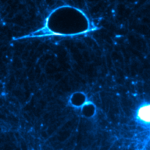Link to Pubmed [PMID] – 28317937
Sci Rep 2017 Mar;7:44779
The E3 ubiquitin ligase HACE1 is a potent tumor suppressor that controls cell proliferation and ubiquitylates the small GTPase Rac1 to target it to proteasomal degradation. Whether and how the activity of HACE1 is regulated by the N-terminal ankyrin (ANK) and the middle (MID) domains is ill defined. Here, we identified in the version 64 of the Catalogue of Somatic Mutations in Cancer (COSMIC) 13 missense mutations of hace1 located outside the HECT domain, and found that all lead to defective control of cell proliferation. In addition, several mutations located in the ankyrin domain displayed a dramatic reduction in Rac1 ubiquitylation associated with a decrease of colony formation in soft agar. 3D structure modelling of the 7 ankyrin-repeats coupled to functional analysis identified a surface epitope centered on one of the mutated residue, Gly-175, which is critical for controlling Rac1 binding and ubiquitylation. We also identified a role for the MID domain in conferring the specificity of association of HACE1 to the active form of Rac1. Our study of the functional interplay between HACE1 and Rac1 in cancer thus sheds a new light on the molecular mechanism of Rac1 ubiquitylation by HACE1 and the impact of its cancer-associated mutations in cell proliferation.

